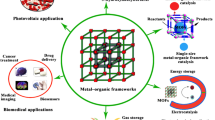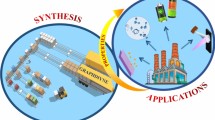Abstract
A novel strategy was developed for tailoring of SiO2 and TiO2 nanoparticle surfaces with poly(ε-caprolactone) (PCL). Thus, a self-curable polyester, poly(2-hydroxypropylene maleate) was adsorbed on the nanoparticle surfaces and heated to 180 °C to give a cross-linked polyester layer with residual hydroxyalkyl groups on their surfaces. Surface-initiated polymerization of ε-caprolactone from hydroxyalkyl groups on the surfaces yielded core-shell nanoparticles with cross-linked core and PCL shells (22.2–71.4%). The organic shell layers around the nanoparticle cores were evidenced by transmission electron microscopy, dynamic light scattering, and thermogravimetric analyses techniques. The core-shell nanoparticles were then employed in preparing the stable and the homogenous dispersions with poly(methyl methacrylate-stat-butyl acrylate) solutions. An application of the solutions onto glass substrates yielded uniform and nearly transparent free standing films (40–60 μm) with good homogeneity as inferred from scanning electron microscopy pictures.









Similar content being viewed by others
References
Wang Y, Herron N (1991) J Phys Chem 95:525
See KH, Mullins ME, Mill OP, Heiden PA (2005) Nanotechnology 16:1950
Liu P, Su Z (2006) J Macromol Sci Part B Phys 45:131–138
Demir MM, Memesa M, Castignolles P, Wegner G (2006) Macromol Rapid Comm 27:763
Russell TP (2002) Science 297:964
Huang X, Wirth MJ (1999) Macromolecules 32:1694
Jordan R, Ulman A, Kang JF, Rafailovich MH, Sokolov J (1999) J Am Chem Soc 121:1016
Kickelbick G (2003) Prog Polym Sci 28:83
Wuelfing WP, Gross SM, Miles DT, Murray RW (1998) J Am Chem Soc 120:12696
Abboud M, Turner M, Duguet E, Fontanille M (1997) J Mater Chem 7:1527
Prucker O, Ruhe J (1998) Macromolecules 31:602
Prucker O, Ruhe J (1998) Macromolecules 31:592
Kim NY, Jeon NL, Choi IS, Takami S, Harada Y, Finnie KR, Girolami GS, Nuzzo RG, Whitesides GM, Laibinis PE (2000) Macromolecules 33:2793
Jordi MA, Seery TAP (2005) J Am Chem Soc 127:4416
Böttcher H, Hallensleben ML, Nuß S, Wurm H (2000) Polym Bull 44:223
Xia J, Matyjaszewski K (1997) Macromolecules 30:7697
Husseman M, Malmstrom EE, McNamara M, Mate M, Mecerreyes D, Benoit DG, Hedrick JL, Mansky P, Huang E, Russell TP, Hawker CJ (1999) Macromolecules 32:1424
Carrot G, Rutot-Houze D, Pottier A, Degee P, Hilborn J, Dubois P (2002) Macromolecules 35:8400
Bailly B, Donnenwirth AC, Bartholome C, Beyou E, Bourgeat-Lami E (2006) J Nanomater 1:1
Bicak N, Karagoz B, Tunca U (2003) J Polym Sci Part A-Polym Chem 41:2549
Acknowledgement
The authors thank the bilateral agreement between the Scientific and Technological Research Council of Turkey (TUBITAK) and the CNR Italy (TBAG-U/125, 104T266) for financial support of the work.
Author information
Authors and Affiliations
Corresponding author
Electronic supplementary materials
Below is the link to the electronic supplementary material.
ESM 1
Synthesis of poly(2-hydroxypropylene maleate) PHPM and adsorption of the polyester on the microparticle surfaces and thermal cross-linking are given as an experimental information. Cured and Poly(ε-caprolactone) grafted SiO2 and TiO2 Nanopowders TGA Measurements. XRD Spectra of pure and polyester cured SiO2 and TiO2 nanopowders. (PDF 588 kb)
Rights and permissions
About this article
Cite this article
Karagoz, B., Galli, G., Durmaz, H. et al. Novel strategy for tailoring of SiO2 and TiO2 nanoparticle surfaces with poly(ε-caprolactone). Colloid Polym Sci 288, 535–542 (2010). https://doi.org/10.1007/s00396-009-2167-0
Received:
Accepted:
Published:
Issue Date:
DOI: https://doi.org/10.1007/s00396-009-2167-0




